icerider
100 W
OK, laugh at me if you must, but I am addicted to the seamless integration of the Bionx system. The torque sensitive assist just makes the Bionx system fun to ride, and if that KEEPS ME RIDING then all is well.
Also, I live in Tucson, AZ and for some reason, used Bionx bikes and systems have been cheap around here recently. I bought a 2009 Terratrike Power Cruiser for $1000 in good shape. It had an old PL350 37V I2C system on it which had some idiosyncrasies like turning off every 15 minutes (some kind of keep-alive signal not being processed properly). A nuisance but it didn't keep me from putting 3000+ miles on the bike or from adapting it for solar power (http://www.endless-sphere.com/forums/viewtopic.php?f=3&t=62700). I recently purchased a used PL350 // 48V // 8.8 Ah Bionx system for $300 and moved it onto the Terratrike Cruiser for the cost of a wheel build.
About a year before I bought the Terratrike, I got a used Trek Valencia+ (PL350, 41V, 6.6 Ah Bionx) for $600. One ride on that bike and I simply couldn't NOT buy it. It was purely and simply a joy to ride. So things had fallen into a routine, I rode the Terratrike by myself in the mornings, high assist, very fast and alone in the dark and I rode the Trek Valencia+ with friends, minimum assist and much slower. It had good range for that kind of riding, 35+ miles with some battery left.
So things were fine until I started mixing up the morning ride and using the Trek on some mornings. I quickly discovered that the range of the Trek Valencia+ was VERY limited in the highest assist mode. It would begin to drop into the low-battery current-limited-assist mode after as few as 6 miles. Given the good range in low assist levels, that was unexpected. A couple of hours in the diagnostic mode (code 3772) verified that the real problem was not so much battery capacity, as voltage drop (or sag). The measured battery voltage was falling several volts under load and the controller was taking the minimum voltage measured as the indicator of battery-remaining. If that had only affected the battery-remaining indicator on the controller it would have been no issue, but it also initiated the LVC protections including the reduced-current mode which would come and go as the terrain changed. Nice and fast on the flat, MUCH reduced assistance on the hills -- great exercise, but frustrating.
I carefully cleaned all the battery connectors and the problem got a little better (or seemed to) but it was still easy to ride the bike into the LVC protections. So it seems likely that the underlying problem is probably a bank of cells beginning to go high resistance in the battery. It still charges fully and quickly so there is life left, but ... A quick conversation with Bionx and Trek made it clear that all my options for a new battery were going to cost ~$1000 or so. Now I don't mind paying for good components and the Valencia+ is a 2011 model so I don't think I have any real complaint about the battery life, but... Since the battery is out of warranty and I know what the bottom line is for a new battery is... Oh well, it won't be the first Bionx battery I went into (or the last I suspect). I already know that the early Bionx batteries did not include any kind of cell-balance function so if the Trek is the same, I can parallel in a new battery pretty simply and a LOT more cheaply, and if I really need a new battery eventually, so be it.
So here we go:
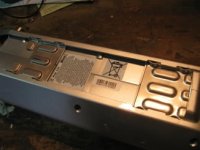
Note the clips on the bottom of the battery also interlock with the battery housing. This is NOT going to be as easy as the down-tube batteries I have opened before. First, remove the four machine screws that hold the battery housing together, and then pull the tail light:
View attachment 7
Lift the little plastic "ears" that link the rack-clips and the battery housing and remove the rack-clips and start prying on the halves of the battery housing:

I am leaving more marks on the battery housing than I like but I don't know any other way to get this open.
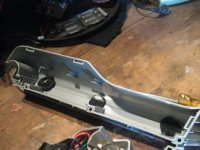
So with the housing opened, I can see why it was so hard to get started opening the case. That Silicon RTV had a pretty good grip on the battery pack inside.
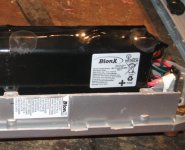
And we have the battery pack specs
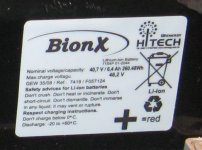
And the battery pack is correctly identified as an 11s4p 40.7V nominal 6.4Ah pack. Interestingly, the batteries are arranged in 5 chunks that are packaged end-to-end rather than side by side. A lower layer of 24 (6x4) and an upper layer of 20 (5x4) for a total of 44.
Now for the best part, there are only 3 wires going into the battery pack -- no cell-balance function !!!!!! cool !!!! This is going to be easy.
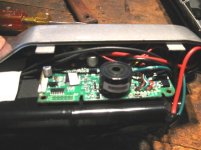
And so tapping into the battery is trivial. cut away a little insulation and solder in a 14 gauge stranded copper tap on each leg (positive and negative). And yes, I an out of black wire so BOTH of the tap wires will be red. I took a black magic marker to the other end to make it PLAIN which is positive and negative. I am still a LIPO-fire virgin and I would like to stay that way.
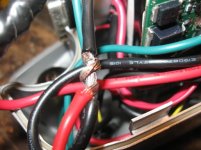
A lot of heavy electrical tape, wires carefully laid back into the battery and immobilized (so there will be no wear on them) , drill a small hole in the case and bring out the 14 gauge tap wires, and I am ready to add 11s1p 5Ah of Turnigy 20C LIPO battery (that I just HAPPEN to have lying around). The LIPO bricks are a 5s and a 6s brick wired in series and wrapped in bubble wrap in a small plastic case that fits nicely in the little bag on my rear rack. From previous use, I know that I can charge the LIPO pack by just leaving it hooked up and attaching the Bionx charger to the whole mess. I check the LIPO balance every 5 charges or so and have only balanced them once in 90 days of continuous use. I expect the same from this arrangement but time will tell.
I check the voltages on the Bionx battery and the LIPO pack and decide that I need to do something about the 0.5V difference between them. A 1 ohm wirewound resister fixes the imbalance in about 45 minutes. they are within 20mv when I hook in the LIPO. I should have something like 10Ah of battery.
The first test drive is simply a test to see how much battery I REALLY have. I run with high assist, continuous max throttle, pedaling moderately on the uphills, staying right at the Bionx 20 mph limit more or less continuously. It goes 14.5 miles before it enters the current-limited low battery mode. From experience I know there are 2-3 miles of additional battery left if I drop down to the lower assist levels and slow down, but that is enough for this test. I Like this arrangement.
For comparison, I went to (http://www.ebikes.ca/tools/simulator.html) and ran a simulation of this arrangement:
A NOD TO BIONX AND TREK: Two quick things to mention. Both Bionx and Trek have always responded well when I contacted them. This little experiment is happening because I find it interesting and not because I am in any way dissatisfied with Trek or Bionx. I LOVE the Bionx integration and operation, and the TREK Valencia+ is a BEAUTIFUL implementation of that system. I would also note that the newer Bionx batteries that I have opened do, in fact, have a cell balance function and that the older batteries use the 18650V or VT LiMn batteries that are known for their self-balancing ability. I now have over 4500 miles on several different Bionx products continue to be delighted with the on-road experience and reliability.
FINAL DISCLAIMER: I am not recommending that ANYONE else try this or in any way suggesting that it is safe. I have clearly violated any warranty on the battery and putting different battery chemistry(s) in parallel is a USDA good way to start a fire. If anyone copies this or a similar arrangement, they do so entirely at their own risk.
Also, I live in Tucson, AZ and for some reason, used Bionx bikes and systems have been cheap around here recently. I bought a 2009 Terratrike Power Cruiser for $1000 in good shape. It had an old PL350 37V I2C system on it which had some idiosyncrasies like turning off every 15 minutes (some kind of keep-alive signal not being processed properly). A nuisance but it didn't keep me from putting 3000+ miles on the bike or from adapting it for solar power (http://www.endless-sphere.com/forums/viewtopic.php?f=3&t=62700). I recently purchased a used PL350 // 48V // 8.8 Ah Bionx system for $300 and moved it onto the Terratrike Cruiser for the cost of a wheel build.
About a year before I bought the Terratrike, I got a used Trek Valencia+ (PL350, 41V, 6.6 Ah Bionx) for $600. One ride on that bike and I simply couldn't NOT buy it. It was purely and simply a joy to ride. So things had fallen into a routine, I rode the Terratrike by myself in the mornings, high assist, very fast and alone in the dark and I rode the Trek Valencia+ with friends, minimum assist and much slower. It had good range for that kind of riding, 35+ miles with some battery left.
So things were fine until I started mixing up the morning ride and using the Trek on some mornings. I quickly discovered that the range of the Trek Valencia+ was VERY limited in the highest assist mode. It would begin to drop into the low-battery current-limited-assist mode after as few as 6 miles. Given the good range in low assist levels, that was unexpected. A couple of hours in the diagnostic mode (code 3772) verified that the real problem was not so much battery capacity, as voltage drop (or sag). The measured battery voltage was falling several volts under load and the controller was taking the minimum voltage measured as the indicator of battery-remaining. If that had only affected the battery-remaining indicator on the controller it would have been no issue, but it also initiated the LVC protections including the reduced-current mode which would come and go as the terrain changed. Nice and fast on the flat, MUCH reduced assistance on the hills -- great exercise, but frustrating.
I carefully cleaned all the battery connectors and the problem got a little better (or seemed to) but it was still easy to ride the bike into the LVC protections. So it seems likely that the underlying problem is probably a bank of cells beginning to go high resistance in the battery. It still charges fully and quickly so there is life left, but ... A quick conversation with Bionx and Trek made it clear that all my options for a new battery were going to cost ~$1000 or so. Now I don't mind paying for good components and the Valencia+ is a 2011 model so I don't think I have any real complaint about the battery life, but... Since the battery is out of warranty and I know what the bottom line is for a new battery is... Oh well, it won't be the first Bionx battery I went into (or the last I suspect). I already know that the early Bionx batteries did not include any kind of cell-balance function so if the Trek is the same, I can parallel in a new battery pretty simply and a LOT more cheaply, and if I really need a new battery eventually, so be it.
So here we go:

Note the clips on the bottom of the battery also interlock with the battery housing. This is NOT going to be as easy as the down-tube batteries I have opened before. First, remove the four machine screws that hold the battery housing together, and then pull the tail light:
View attachment 7
Lift the little plastic "ears" that link the rack-clips and the battery housing and remove the rack-clips and start prying on the halves of the battery housing:

I am leaving more marks on the battery housing than I like but I don't know any other way to get this open.

So with the housing opened, I can see why it was so hard to get started opening the case. That Silicon RTV had a pretty good grip on the battery pack inside.

And we have the battery pack specs

And the battery pack is correctly identified as an 11s4p 40.7V nominal 6.4Ah pack. Interestingly, the batteries are arranged in 5 chunks that are packaged end-to-end rather than side by side. A lower layer of 24 (6x4) and an upper layer of 20 (5x4) for a total of 44.
Now for the best part, there are only 3 wires going into the battery pack -- no cell-balance function !!!!!! cool !!!! This is going to be easy.

And so tapping into the battery is trivial. cut away a little insulation and solder in a 14 gauge stranded copper tap on each leg (positive and negative). And yes, I an out of black wire so BOTH of the tap wires will be red. I took a black magic marker to the other end to make it PLAIN which is positive and negative. I am still a LIPO-fire virgin and I would like to stay that way.

A lot of heavy electrical tape, wires carefully laid back into the battery and immobilized (so there will be no wear on them) , drill a small hole in the case and bring out the 14 gauge tap wires, and I am ready to add 11s1p 5Ah of Turnigy 20C LIPO battery (that I just HAPPEN to have lying around). The LIPO bricks are a 5s and a 6s brick wired in series and wrapped in bubble wrap in a small plastic case that fits nicely in the little bag on my rear rack. From previous use, I know that I can charge the LIPO pack by just leaving it hooked up and attaching the Bionx charger to the whole mess. I check the LIPO balance every 5 charges or so and have only balanced them once in 90 days of continuous use. I expect the same from this arrangement but time will tell.
I check the voltages on the Bionx battery and the LIPO pack and decide that I need to do something about the 0.5V difference between them. A 1 ohm wirewound resister fixes the imbalance in about 45 minutes. they are within 20mv when I hook in the LIPO. I should have something like 10Ah of battery.
The first test drive is simply a test to see how much battery I REALLY have. I run with high assist, continuous max throttle, pedaling moderately on the uphills, staying right at the Bionx 20 mph limit more or less continuously. It goes 14.5 miles before it enters the current-limited low battery mode. From experience I know there are 2-3 miles of additional battery left if I drop down to the lower assist levels and slow down, but that is enough for this test. I Like this arrangement.
For comparison, I went to (http://www.ebikes.ca/tools/simulator.html) and ran a simulation of this arrangement:
A NOD TO BIONX AND TREK: Two quick things to mention. Both Bionx and Trek have always responded well when I contacted them. This little experiment is happening because I find it interesting and not because I am in any way dissatisfied with Trek or Bionx. I LOVE the Bionx integration and operation, and the TREK Valencia+ is a BEAUTIFUL implementation of that system. I would also note that the newer Bionx batteries that I have opened do, in fact, have a cell balance function and that the older batteries use the 18650V or VT LiMn batteries that are known for their self-balancing ability. I now have over 4500 miles on several different Bionx products continue to be delighted with the on-road experience and reliability.
FINAL DISCLAIMER: I am not recommending that ANYONE else try this or in any way suggesting that it is safe. I have clearly violated any warranty on the battery and putting different battery chemistry(s) in parallel is a USDA good way to start a fire. If anyone copies this or a similar arrangement, they do so entirely at their own risk.

